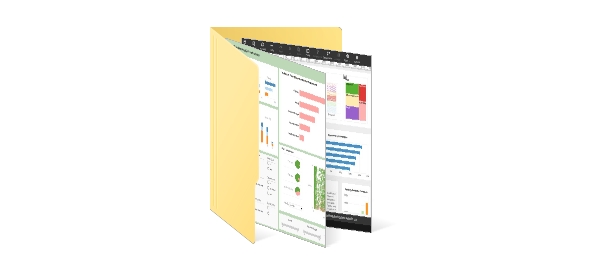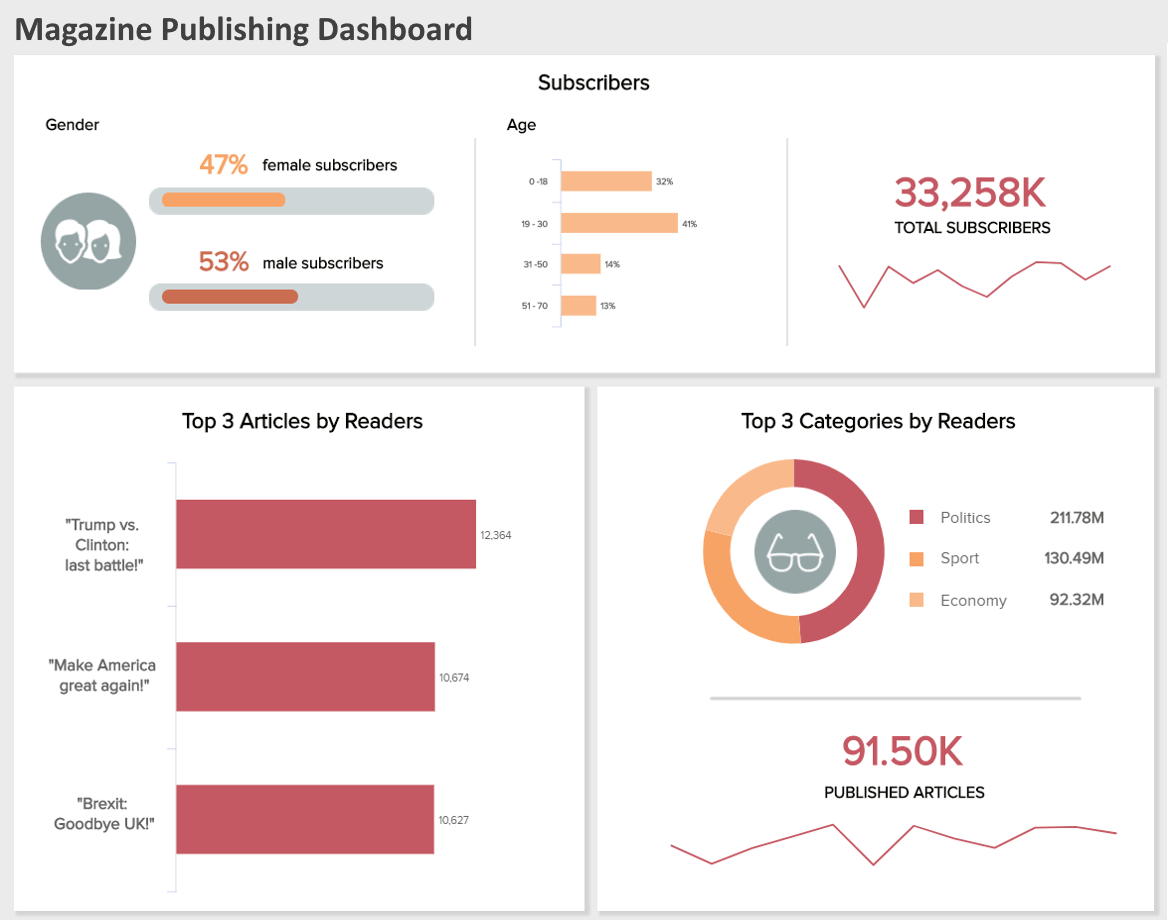What KPIs and Analytics Are Used on a Magazine Publisher's Dashboard?
For success, data-driven insights are now essential. Key Performance Indicators (KPIs) are used by magazine publishers, both conventional and digital, to track, evaluate, and improve their business operations.
These KPIs provide useful information on numerous business factors, assisting publishers in making choices and adjusting to changing consumer tastes and market trends.
| #1 Ranking: Read how InetSoft was rated #1 for user adoption in G2's user survey-based index | Read More |
Audience Engagement Metrics
The success of a magazine publisher depends critically on their ability to comprehend how consumers engage with the material. Metrics for measuring audience engagement include a variety of variables that reflect reader interest. Pageviews, time spent on page, bounce rate, and scroll depth are metrics that may be used to measure how engaging the content is and if the target audience finds it interesting. Citation counts are particularly valuable.
Subscription and Revenue Metrics
Tracking metrics connected to subscriptions is crucial for publishers that provide subscription-based business models. Metrics like average revenue per user (ARPU), customer lifetime value (CLTV), and subscriber growth rate provide information on the health of the subscriber base and the total amount of income earned. These data aid in making tactical choices that will increase subscriber retention and draw in new ones.
Ad Performance Metrics
For many publishers, advertising money is a major source of income. Metrics for measuring the efficacy of advertising campaigns and placements are quite useful. Publishers may assess the effectiveness of advertising and refine their plans to increase profits by using metrics like click-through rate (CTR), conversion rate, ad viewability, and Cost Per Mille/Thousand (CPM).
Content Popularity and Effectiveness
For publishers, the popularity of certain content pieces may be a treasure mine of information. Measures such as social shares, comments, and inbound links show how well the audience responds to the material. Publishers may improve their content strategy and concentrate on writing pieces that increase traffic and interaction by monitoring these indicators.
Geographic and Demographic Metrics
Understanding the audience's regional and demographic makeup might help you better understand your target readership. Publishers may better adapt content and marketing initiatives by using metrics like geography, age, gender, and hobbies.
Conversion and Sales Metrics
It's critical for publishers with e-commerce components to keep an eye on conversion and revenue numbers. Insights into the efficiency of the e-commerce platform and the buying habits of readers who later became customers may be gained from metrics like conversion rate, average order value, and abandoned cart rate.
Social Media Reach and Impact
Social media is a potent tool for audience interaction and content marketing in the digital age. Social media metrics like followers, likes, shares, and comments provide a window into the brand's influence and reach in the social realm.
 |
Learn about the top 10 features of embedded business intelligence. |
Email Campaign Performance
Email marketing is still an effective way to interact with readers. Email campaign metrics like open rate, click-through rate, and unsubscribe rate show how well communication methods work and how well the material is being delivered to subscribers' inboxes.
Mobile and Desktop Engagement
Tracking interaction metrics for mobile and desktop users is crucial since readers consume content using a number of platforms. The user experience across platforms may be improved by taking into account the readers' preferred devices as well as statistics like mobile bounce rate and time spent on various devices.
Editorial and Production Efficiency
For deadlines to be met and resources to be effectively managed, content development and production must be efficient. Metrics like the time it takes to finish an article, the length of the editing cycle, and the efficacy of cooperation provide information about the workflow's efficiency and potential for process optimization.
User Behavior Flow
Analyzing the user's path around a website might provide useful information about how readers consume the material. Understanding user behavior flow makes it possible to spot places where readers lose interest and possibilities to improve the user experience as a whole.
 |
Learn the advantages of InetSoft's small footprint BI platform. |
Return on Investment (ROI) Metrics
Publishers must ultimately assess the return on their investments. A variety of indications are included in ROI measures, such as marketing ROI, content ROI, and platform ROI. Publishers may effectively distribute resources for greatest impact using these criteria.
Page Load Speed and Performance
In the digital world, website performance has a big impact on user experience. Reader retention depends heavily on measures for page load speed, such as page load time and server response time. These metrics are crucial for making sure that users have a flawless online experience since a sluggish website might result in high bounce rates and poor engagement.
Search Engine Rankings
Visibility on search engines is crucial for generating organic visitors. Publishers may evaluate the success of their SEO initiatives by monitoring search engine rankings for relevant keywords. Publishers may increase the discoverability of their material by keeping an eye on their rankings in search results.
Reader Satisfaction and Feedback
Reader feedback offers insightful information about their satisfaction levels and opportunities for development. Metrics like reader feedback sentiment analysis, Net Promoter Score (NPS), and customer satisfaction surveys provide a qualitative view of how well the publisher is living up to audience expectations.
Read what InetSoft customers and partners have said about their selection of Style Report as their production reporting tool. |
Editorial Calendar Adherence
Meeting publishing deadlines and keeping consistency require adhering to the editorial schedule. The publication schedule is efficiently handled with the use of metrics relating to editorial calendar adherence, such as timely content delivery and consistency in publishing frequency.
Video Engagement Metrics
Monitoring video engagement metrics becomes more important as video content gets more popular. The usefulness of video content may be gleaned from metrics like video views, play-through rates, and engagement rates, which can serve to improve video production techniques.
Subscriber Segmentation and Behavior
The transmission of customized material is made possible by segmenting subscribers based on behavior and preferences. The metrics of subscriber segmentation, segmented email open rates, and click-through rates reveal which material connects with certain subscriber groups, such as gender, age, and country.
Editorial Performance Metrics
Content strategy may be guided by understanding how various portions or categories of material perform. Publishers may more efficiently manage resources and create content that is relevant to audience interests by using metrics like top-performing categories, interesting themes, and average time spent on various forms of content.
 |
Learn how InetSoft's data intelligence technology is central to delivering efficient business intelligence. |
Metrics for Affiliate Marketing
Tracking analytics for click-throughs, conversions, and affiliate earnings is crucial for publishers using affiliate marketing. These indicators assist in evaluating the effectiveness of affiliate relationships and in refining methods to increase profits.
Community Engagement Metrics
A feeling of camaraderie is often fostered among readers of magazines. User-generated content submissions, forum activity, and comments per story are some metrics that show how engaged and interactive the magazine's community is.
Brand Recognition and Sentiment
It's crucial to comprehend how the audience views the brand. The reputation and effect of the magazine are revealed via metrics relating to brand mentions, sentiment analysis of social media discussions, and brand recognition surveys.
Event Participation and Impact
 |
View the gallery of examples of dashboards and visualizations. |
Online and offline events are routinely put on by magazine publishers. The effectiveness of events and their effects on audience engagement are evaluated using metrics including event attendance, participant engagement, and post-event feedback.
Competitor Benchmarking
Context and insights are provided by examining how the magazine performs in comparison to rival publications. Publishers may find opportunities for distinction and development by looking at metrics like market share, audience overlap with rivals, and content performance in comparison to rivals.
Innovation and Experimentation Metrics
To remain relevant in the publishing sector, innovation is essential. Metrics that measure the degree to which novel content formats, platforms, or interactive features are successful may provide light on how successful innovative projects are.




